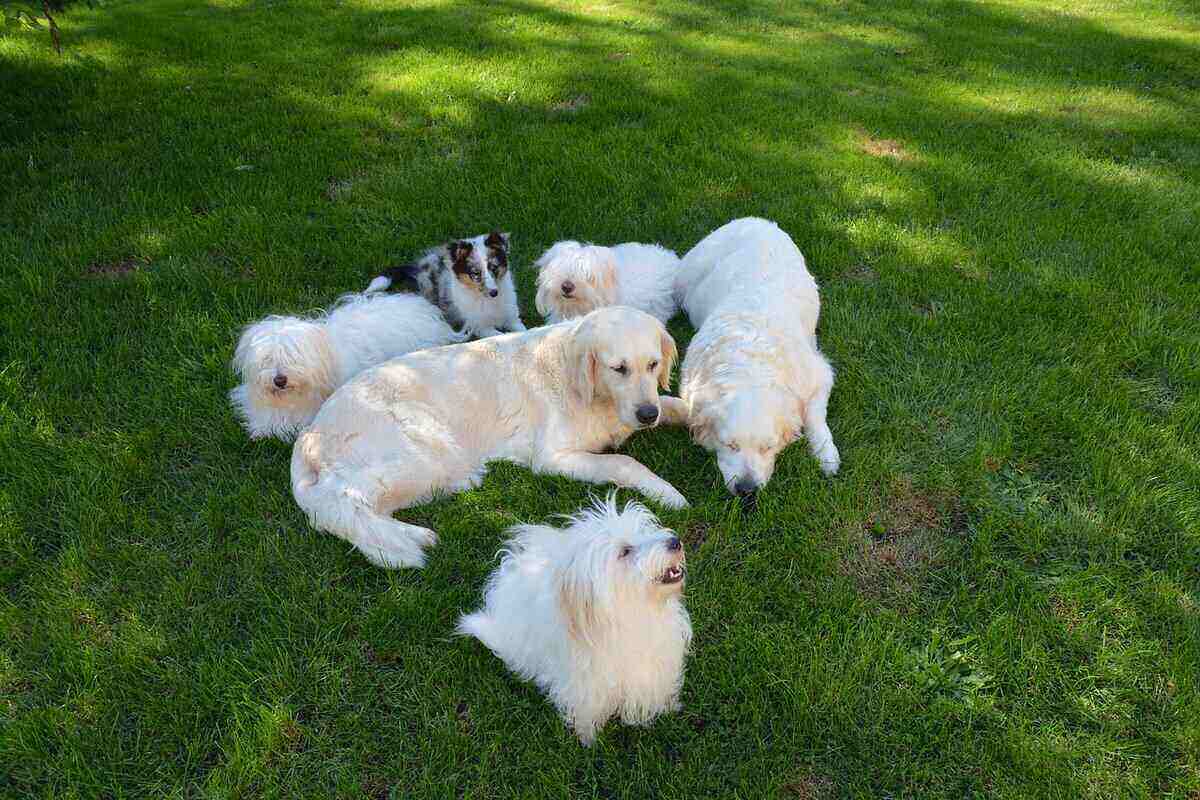
Many dog owners are all too familiar with seeing a barren backyard covered in holes and patches of dead grass. What if you could have a nice lawn and still let your dog play in the yard? We’ve rounded up the 6 best grasses for dogs to help you pick the variety best suited for your furry friend’s shenanigans.
6 best grasses for dogs
All grasses fall into one of two categories: warm-season or cool-season. Choosing the best grass type for your yard depends on your preferences, location, foot traffic rate, landscape characteristics, and sometimes, your pets.
Cool-season grasses

Cool-season grasses thrive when temperatures are between 60 to 75 degrees Fahrenheit. They go dormant after the first frost until the spring, and they begin their active growth seasons in the early spring and again in the early fall. Cool-season cultivars often require more fertilizer and pesticides than warm-season grasses, and they maintain their green color all summer and winter in many transition zone locations.
Some of the best cool-season, dog-friendly varieties include:
Tall fescue

You can’t go wrong with tall fescue if you’re looking for a hardy, drought-resistant, and shade-tolerant grass. Thanks to its deep roots, this grass performs well in areas with heavy foot traffic, high temperatures, and plenty of daily wear and tear.
Tall fescue has a bunch-type growth habit, and most varieties don’t spread on their own. That means you may have to reseed dead spots if your dog ends up causing damage.
- Classification: Cool-season grass
- Spreads by: Bunch-type grass
- Shade tolerance: Moderate
- Drought tolerance: Moderate
- Foot traffic tolerance: Moderate; recovers poorly
- Soil pH: 5.5-6.5
- Soil type: Fertile; good drainage; adaptable
- Maintenance needs: Frequent mowing; does not produce significant thatch
- Mowing height: 2-4 inches
- Potential for disease: Low to moderate; prone to brown patch, seedling disease, and leaf spot
- Other notes: Reseed periodically to repair thinning patches or bare spots; look for newer “turf-type” tall fescue (TTTF) cultivars; seed blends with more than one TTTF type offer the best chance for a strong lawn
Grass Seed Options:
– Triple-Play Tall Fescue Grass Seed Blend (5000 sq ft)
– Eretz Kentucky 31 K31 Tall Fescue Grass Seed (choose your size)
– Pennington The Rebels Tall Fescue Grass Seed Mix (7 lb.)
Kentucky bluegrass
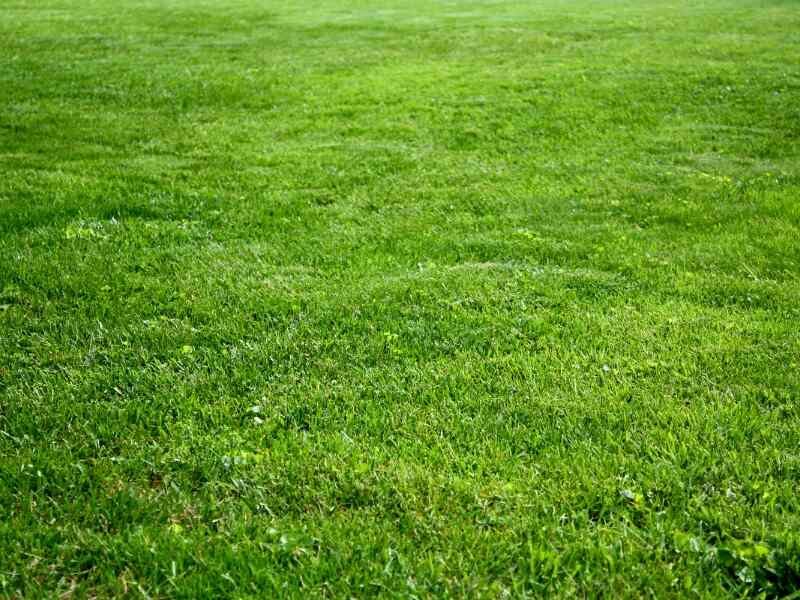
Kentucky bluegrass is a first-rate turfgrass with a high tolerance for foot traffic. It recovers quickly from injury, so active kids and pets won’t be a problem. Unlike tall fescue, this grass spreads by rhizomes, so it can heal damaged spots without reseeding.
Although it takes longer to establish roots and sprout aboveground, Kentucky bluegrass grows quickly once established. And if that’s not enough to convince you, consider its soft texture, perfect for your doggie to roll around in day after day.
- Classification: Cool-season grass
- Spreads by: Rhizomes
- Shade tolerance: Low to moderate; prefers full sun
- Drought tolerance: Moderate; will survive by going dormant
- Foot traffic tolerance: Low to moderate; recovers well
- Soil pH: 6-7
- Soil type: Fertile; good drainage
- Maintenance needs: Moderate mowing frequency; high fertilization needs
- Mowing height: 2-3 inches
- Potential for disease: Moderate to high; prone to necrotic ring spot, summer patch, dollar spot, leaf spot, snow molds, fairy rings, red thread, rust, and powdery mildew.
- Other notes: Produces a dense lawn under ideal conditions; shade tolerance, drought resistance, etc., vary widely by cultivar; newer cultivars are generally hardier, more resistant to disease, etc.; mow taller in summer; typically mixed with other grasses in home lawns
Grass Seed Options:
– Jonathan Green (11970) Blue Panther Kentucky Bluegrass Grass Seed (3 lbs.)
– SeedRanch Midnight Kentucky Bluegrass Seed (5 lbs.)
– Jacklin Seed – Biltmore Blue Blend – 100% Kentucky Bluegrass (5 lbs.)
Perennial ryegrass
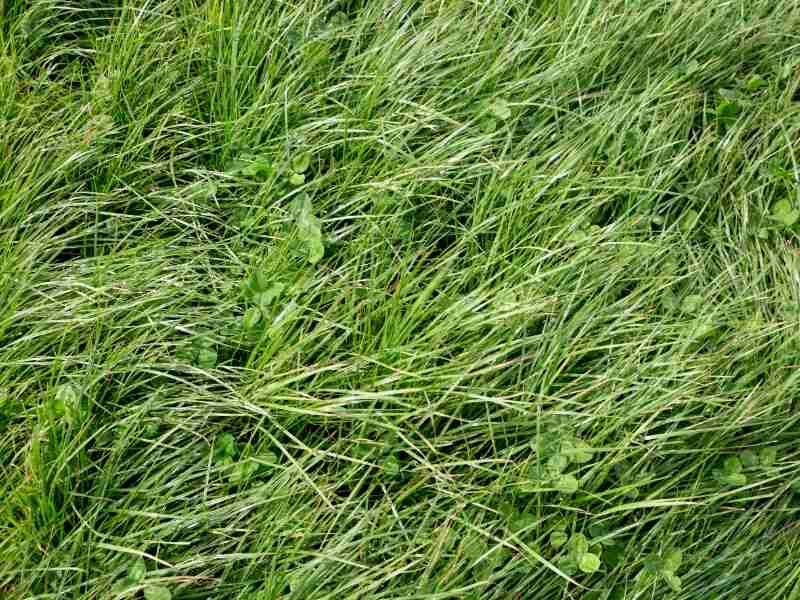
Perennial ryegrass grows well in coastal climates and mild year-round temperatures. It tolerates high traffic and wear and tear, which is perfect for active dogs. However, It doesn’t spread by rhizomes or stolons, so it won’t heal bare spots. Furthermore, the cool-season turfgrass doesn’t tolerate heat, shade, or drought well.
Perennial rye germinates faster than most grass types, and it is the best grass type for reseeding dead patches of grass caused by dog urine or digging. It also mixes well with other grass types, so you can use it to fix dog-related damage in your lawn no matter what grass cultivar you have.
- Classification: Cool-season grass
- Spreads by: Bunch-type grass
- Shade tolerance: Low; prefers full sun
- Drought tolerance: Low; summer dormancy in some areas
- Foot traffic tolerance: High; recovers poorly
- Soil pH: 6-7
- Soil type: Fertile; good drainage
- Maintenance needs: Moderate mowing and fertilization requirements; thatch is not significant
- Mowing height: 2-3 inches
- Potential for disease: High; susceptible to gray leaf spot, dollar spot, brown patch, red thread, rust, and pythium blight
- Other notes: Often mixed with Kentucky bluegrass and fine fescue; excellent striping ability; germinates rapidly for a temporary lawn
Grass Seed Options:
– Outsidepride Perennial Ryegrass Seed (5 lbs.)
– Eretz ProTurf Perennial Ryegrass Fine Lawn Seed (choose your size)
Warm-season grasses
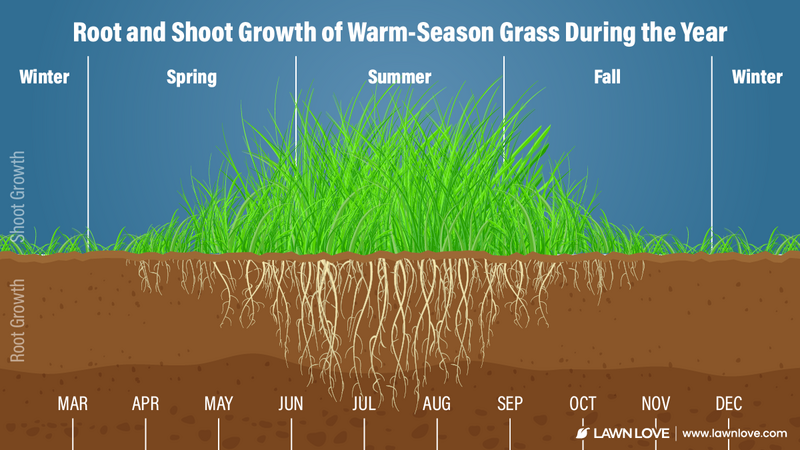
Warm-season grasses thrive in temperatures between 80 to 95 degrees Fahrenheit. They grow best in the Southern half of the United States, and they begin their active growing season in the spring and go dormant in the early to mid-fall. Warm-season varieties are drought- and heat-tolerant but can’t handle frost and extreme cold.
Check out some dog-friendly warm-season cultivars:
Bermudagrass

Bermudagrass can survive wear and tear from rambunctious dogs thanks to its dense roots. It’s also drought-tolerant and survives in salty conditions. The high salt tolerance makes Bermudagrass an excellent choice for lawns in coastal cities.
Another great thing about Bermuda is that it grows and spreads rapidly. Even if your dog kills a portion of your lawn, it will recover quickly. However, one downside of this turfgrass is that it does not tolerate shade. It’s also high-maintenance compared to other grass types and needs frequent mowing, watering, and fertilizing to stay healthy.
- Classification: Warm-season grass
- Spreads by: Stolons and rhizomes
- Shade tolerance: Low; thrives in full sun
- Drought tolerance: High
- Foot traffic tolerance: High
- Soil pH: 6-6.5
- Soil type: Tolerates most soil types
- Maintenance needs: Needs frequent mowing due to fast growth rate; develops thatch easily; needs regular fertilization
- Mowing height: 1-2 inches
- Potential for disease: Good disease resistance; can develop spring dead spot, root decline, dollar spot, leaf spot, large patch, and sheath spot
- Other notes: Good tolerance to salt; often grown in coastal areas
Grass Seed Options:
– Pennington Bermudagrass Bare Spot (5 lb. bag)
– Pennington Smart Seed Bermudagrass Mix (8.75-lb. bag)
– Scotts Turf Builder Bermudagrass (10-lb. bag)
– Hancock Seed Co. Bermudagrass (50-lb. bag)
Centipedegrass

As a warm-season grass, centipedegrass has high heat tolerance, bright green foliage, and a dense growth habit, making it the perfect candidate for a dog-friendly landscape. Because it has high watering needs, your dog’s urine dilutes easily, unable to cause much damage to your lawn.
Another point in its favor is that it’s low maintenance and disease- and pest-resistant. And let’s not forget that it doesn’t require regular mowing, dethatching, or feeding, all of which may coincide with any homeowner’s busy schedule.
- Classification: Warm-season grass
- Spreads by: Stolons
- Shade tolerance: Moderate–at least six hours of full sun per day
- Drought resistance: Low to moderate
- Foot traffic tolerance: Low
- Soil pH: 5-6
- Soil type: Acidic, infertile, at least moderately good drainage (very dense, clay soils produce poor results)
- Maintenance needs: Low mowing frequency
- Mowing height: 1.5-2 inches
- Potential for disease: Moderate; prone to centipedegrass decline and iron chlorosis
- Other notes: Low maintenance once established; greenish-yellow color (like a green apple) during the growing season; low fertilizer and mowing requirements; not a salt-tolerant grass
Grass Seed Options:
– Gulf Kist Coated Centipedegrass Seeds (1 lb.)
– Scotts EZ Seed Patch and Repair Centipedegrass (3.75 lbs.)
– TifBlair Centipedegrass (5-lb. bag)
– Pennington Centipedegrass and Mulch (5-lb. bag)
Zoysiagrass

Zoysiagrass is a drought- and heat-tolerant warm-season grass that blooms in May. Thanks to a deep root system, it is more cold and shade-resistant than other warm-season cultivars.
This turfgrass produces a dense, dark-green lawn that requires sharp mower blades, but the great thing about it is that it shields the soil from urine damage. Zoysiagrass spreads by rhizomes and stolons, meaning it can cover dog-related dead patches on its own.
Unfortunately, Zoysiagrass establishes slowly. However, once established it boasts a stiff and prickly texture. Its dense growth causes excessive thatch buildup, so count on dethatching your lawn regularly.
- Classification: Warm-season grass
- Spreads by: Stolons and rhizomes
- Shade tolerance: Moderate
- Drought tolerance: Moderate to High
- Foot traffic tolerance: High; recovers slowly
- Soil pH: 6-6.5
- Soil type: Well-draining; some cultivars are more tolerant of a wide range of soils than others
- Maintenance needs: Moderate; low nitrogen fertilization requirements; prone to thatch
- Mowing height: 1-2.5 inches
- Potential for disease: Good disease tolerance; can develop large patch, root decline, spring dead spot, rust, curvularia, and leaf spot
- Other notes: Moderately salt tolerant; mow at a taller height if the grass is growing in partial shade
Grass Plug and Seed Options:
– Zenith Zenith Grass Seeds (1/8 lb. of seeds)
How can dogs damage your grass?
Damage from pee
From your dog’s perspective, your whole backyard is one big toilet. They’ll pee on the grass, up against the base of plants, on trees, and pretty much anywhere else.
The problem is that dog pee contains a lot of nitrogen. The nitrogen soaks into the soil, reaching your grassroots. In large doses, it causes burns and even kills your grass, leaving brown, dead spots in its wake. Discover the ways dog pee kills grass and how to repair dog pee spots across your lawn.
Damage from poop
If you think it’s OK to slack on picking up dog poop in your backyard, there are a few reasons to reconsider.
Like pee, your dog’s poop contains nitrogen, which can burn your lawn if it has time to break down. And let’s not talk about the host of fungal lawn diseases that can arise from poop left lying in your yard. More importantly, though, dog poop spreads harmful bacteria, which could impact your family, pets, and wildlife.
Damage from digging
It’s obvious how digging holes in your lawn damages grass in the short term. Even the toughest grass can’t survive being completely uprooted.
But regular digging creates long-term problems for your lawn and soil. When your dog digs up the grass, the soil is exposed. Exposed soil dries out and loses nutrients, hindering new growth.
Damage from running
Heavy foot traffic–human, canine, or otherwise–smashes grass blades and compacts the soil. Compacted soil means your grass roots can’t access the water and nutrients they need.
The big problem here is that dogs tend to run or walk across the same parts of the lawn every day, whether patrolling the yard’s perimeter or going back and forth between the back door and their doghouse. After a while, those stretches of grass become worn down and may even die.
Pro tip: Solve soil compaction problems by aerating your lawn once a year.
What makes a grass type good for dogs?
Rapid growth rate
The first requirement for a dog-friendly lawn is that the grass grows quickly. That way, even if your dog kills a patch of grass, it will recover on its own.
Grasses that spread using rhizomes or stolons are best because they’ll grow laterally along the ground to fill in bare spots without you having to plant new seeds.
Deep root system
Deep, thick roots make your grass more durable. The deeper and denser the root system, the harder the grass is to damage. Even if your dog pees or rolls around in the same spot every day, grass with deep roots is more likely to survive.
Plus, strong roots discourage digging. The grass is hard to pull up, and the roots block your dog’s access to the soil.
Climate compatibility
If your grass type doesn’t suit your climate, it’s starting on the wrong foot. Grass in an unsuitable climate is already weak and sickly, and your dog may make matters worse.
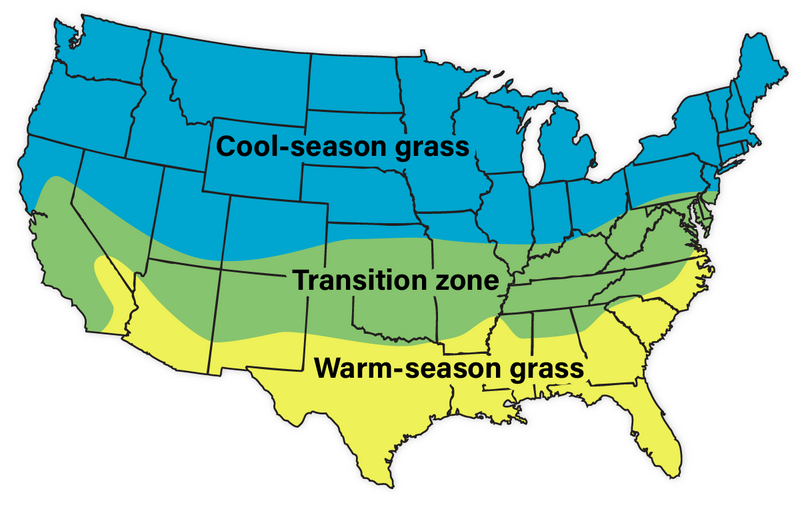
When we’re talking about grass types, the United States is broken up into three climate zones:
- Cool-season zone: The northern part of the country
- Transition Zone: The middle part of the country, where both cool-season and warm-season grasses grow
- Warm-season zone: The southern part of the country
Know your climate zone and choose a grass type that grows well there. You should also consider a grass type’s preferred sun exposure, soil conditions, and maintenance requirements to select the best fit for your yard and lifestyle.
Other dog-friendly landscaping ideas
So, you’ve decided to overseed your lawn with dog-friendly grass to prevent damage from urine, digging, and other not-so-friendly doggy behaviors. Why stop there? There’s a lot more you can do to help your landscape survive Dogzilla and make the backyard more fun for your furry friend at the same time.
Here’s a taste of some paw-some dog-friendly landscaping ideas:
- Give your dog a kiddy pool to cool off in the heat of summer.
- Plant herbs and other plants that repel fleas.
- Replace digging up your lawn with digging in a sandbox.
- Install a path for your dog to walk on so they don’t wear down the grass.
Your new damage-resistant grass is a great first step to a dog-friendly landscape. Once you’re done making over the yard, you, your dog, and your grass will be happier.
FAQ about the best grasses for dogs
What grass type is the most urine-resistant?
Generally speaking, you can count on perennial ryegrass to take the brunt of your dog’s urine. Centipedegrass is another excellent option due to its frequent watering requirement, which ensures that dog urine is never on your lawn for long periods.
Will my dog get sick if they eat grass?
Many dogs like the taste of grass, so don’t be surprised to see your furry friend munching on your lawn now and then. While some dogs benefit from eating grass for digestive reasons, many have health problems for the same reason. Keep a close eye on your dog to see how their body reacts to eating grass and consult with your vet.
Is artificial grass an option if I have a dog?
Artificial grass is safe for your dog. Manufacturers subject their products to strict tests to ensure that harmful, toxic substances are kept out of the process. When shopping around for artificial grass, ask about such certifications for your peace of mind.
Get some help from a pro
If you want a dog-friendly and -resistant lawn, but DIY just isn’t your thing, let Lawn Love connect you with a lawn care professional near you. They’ll handle everything from reseeding, mowing, and fertilizing to other regular maintenance tasks so you have more time for the dog park.
Main Photo Credit: JackieLou DL | Pixabay